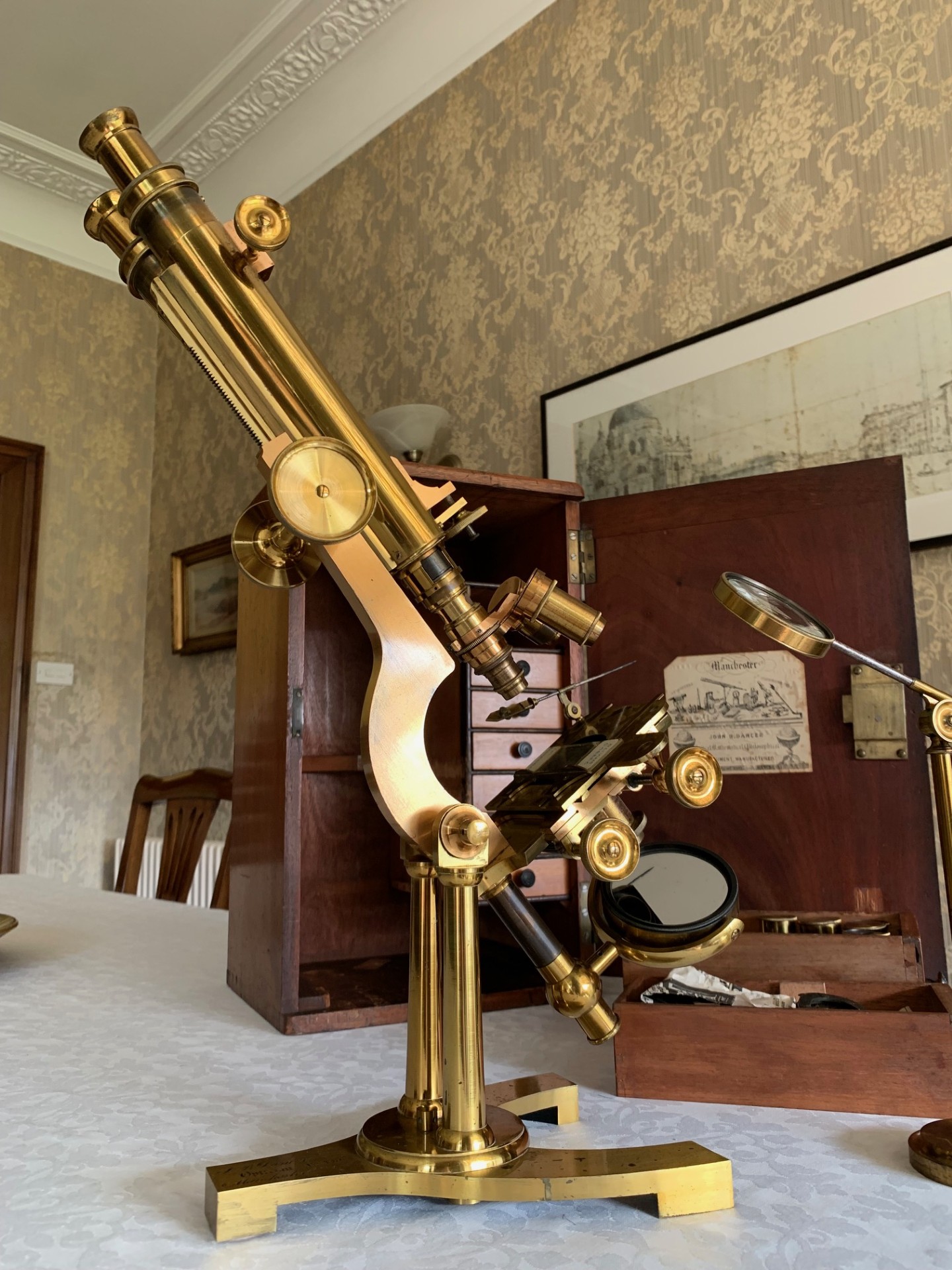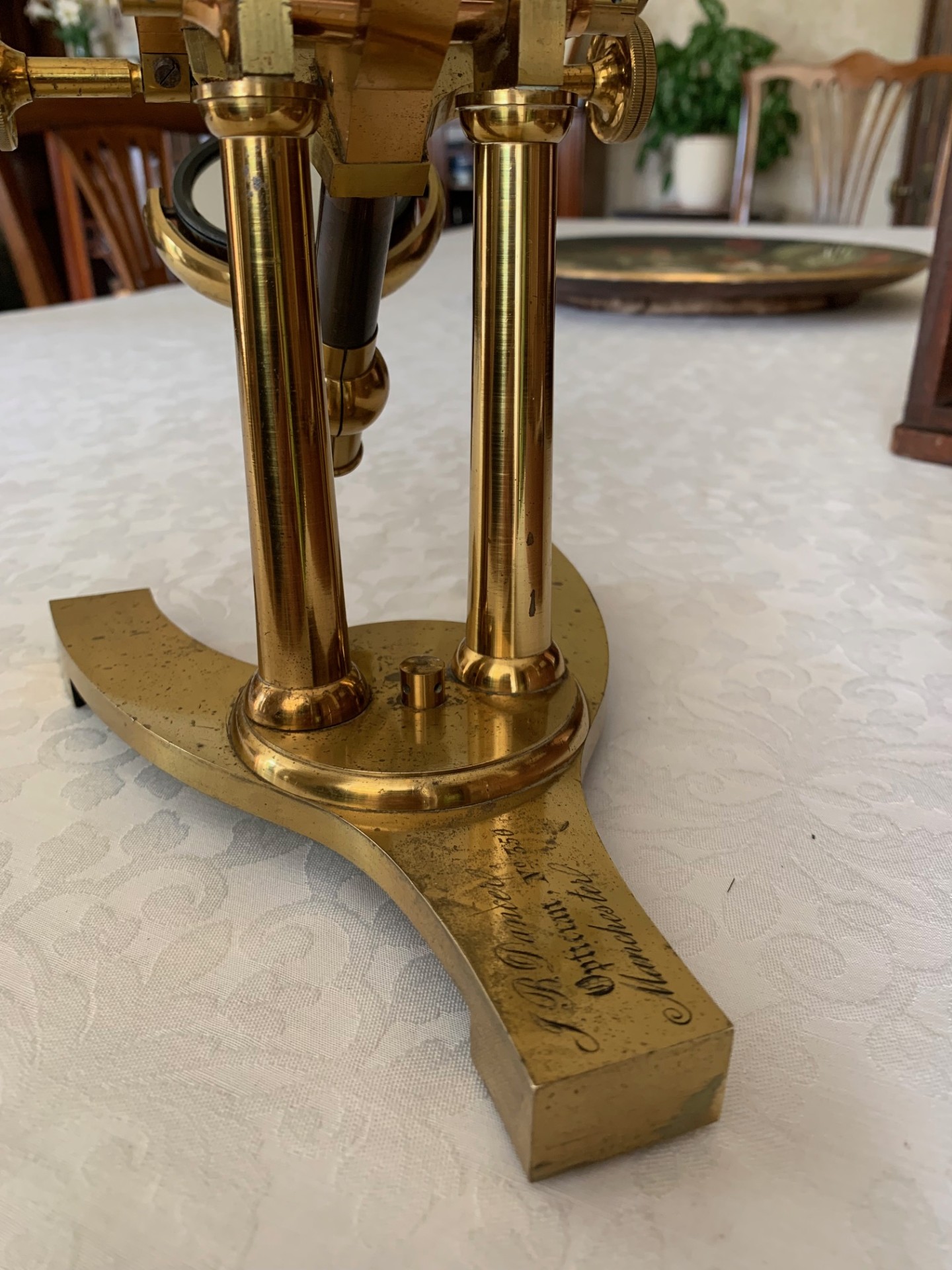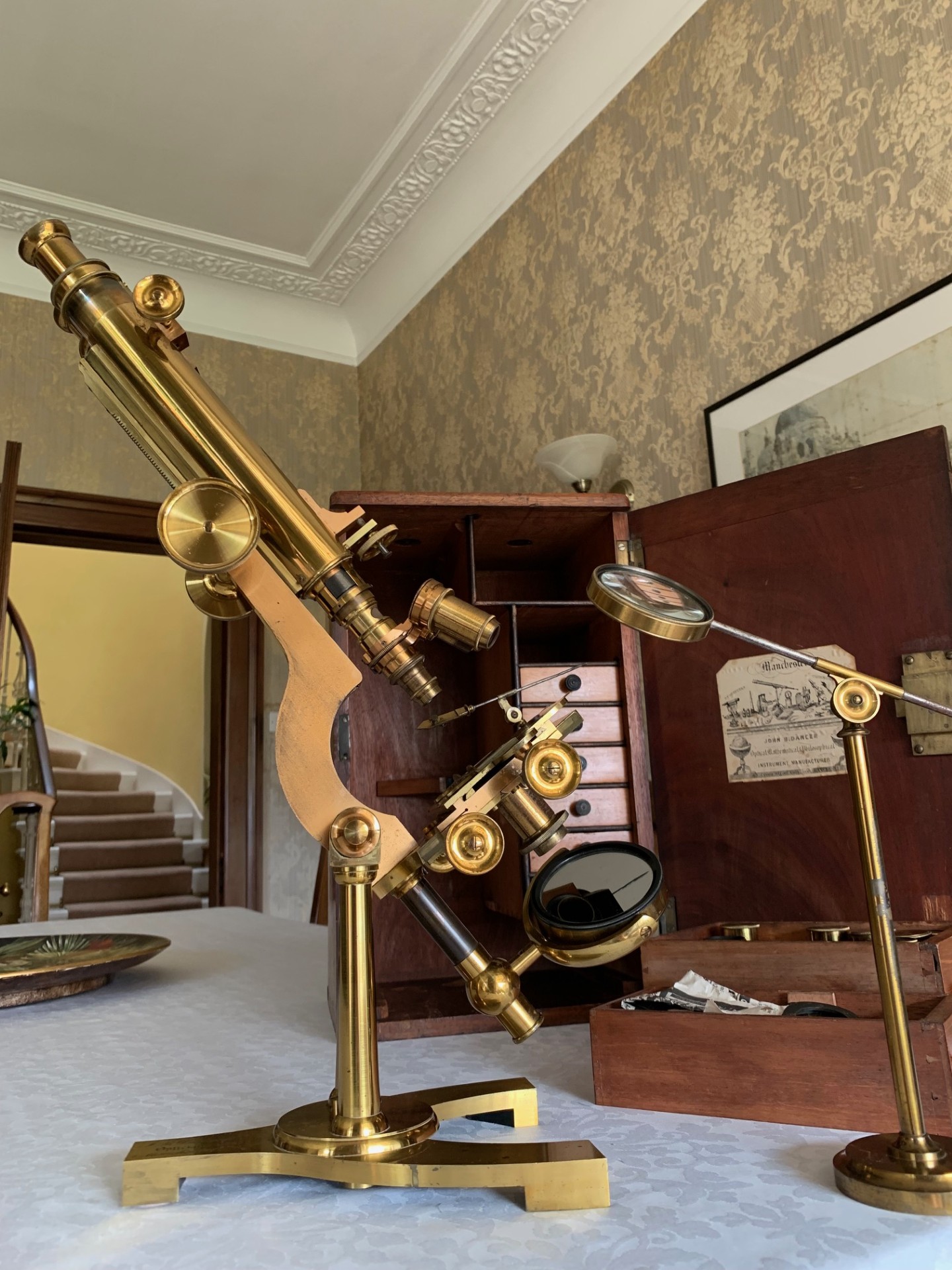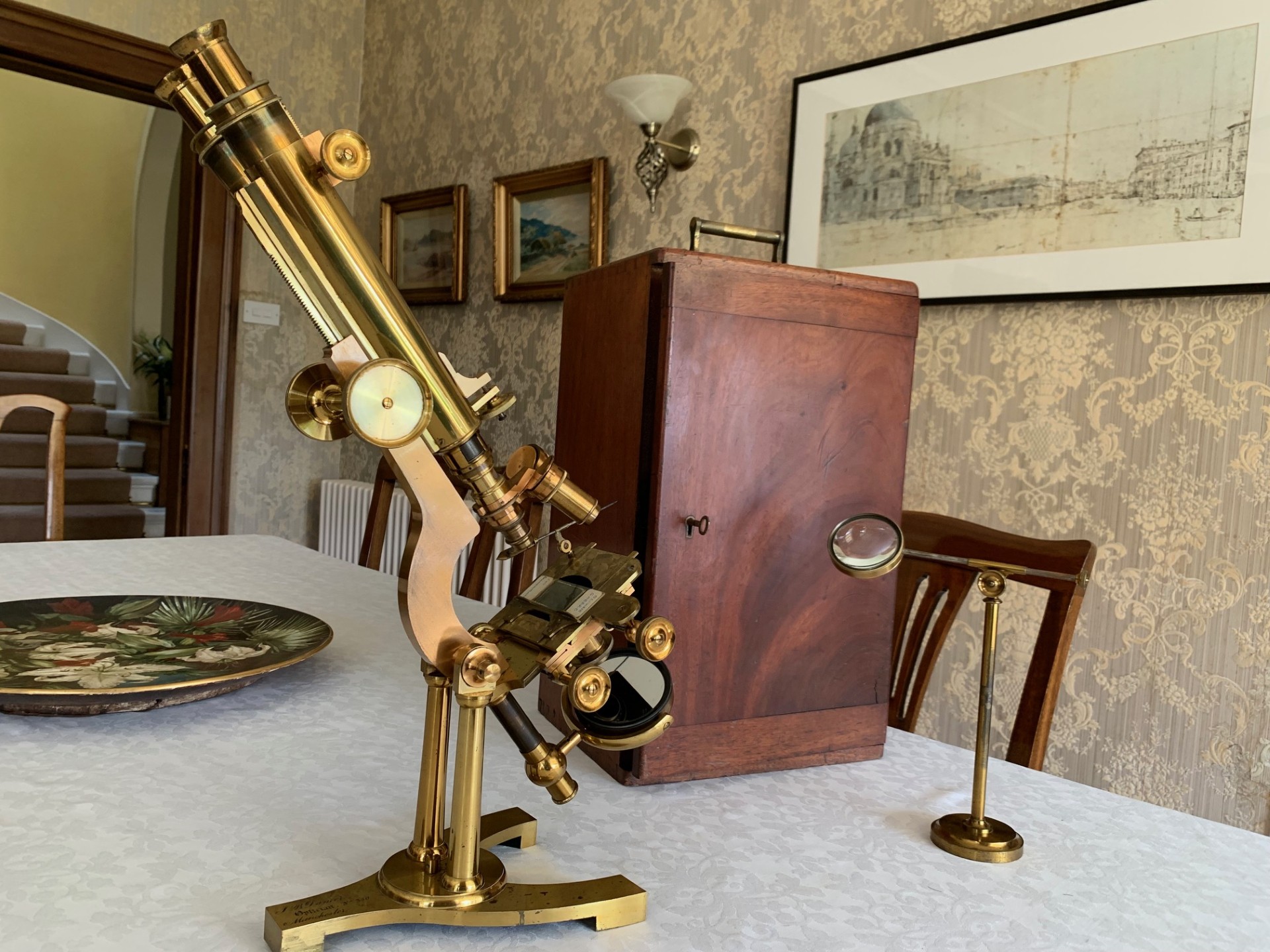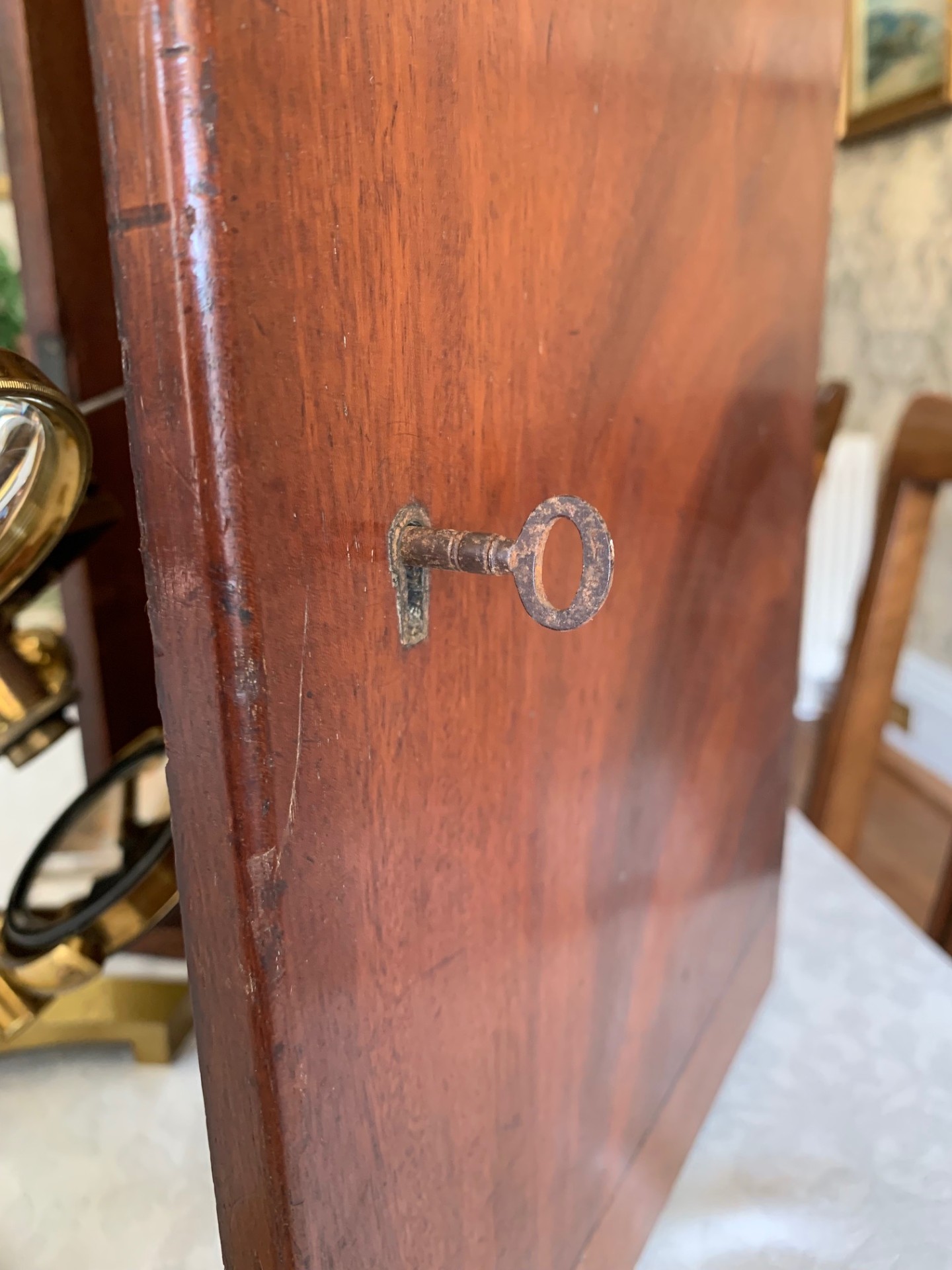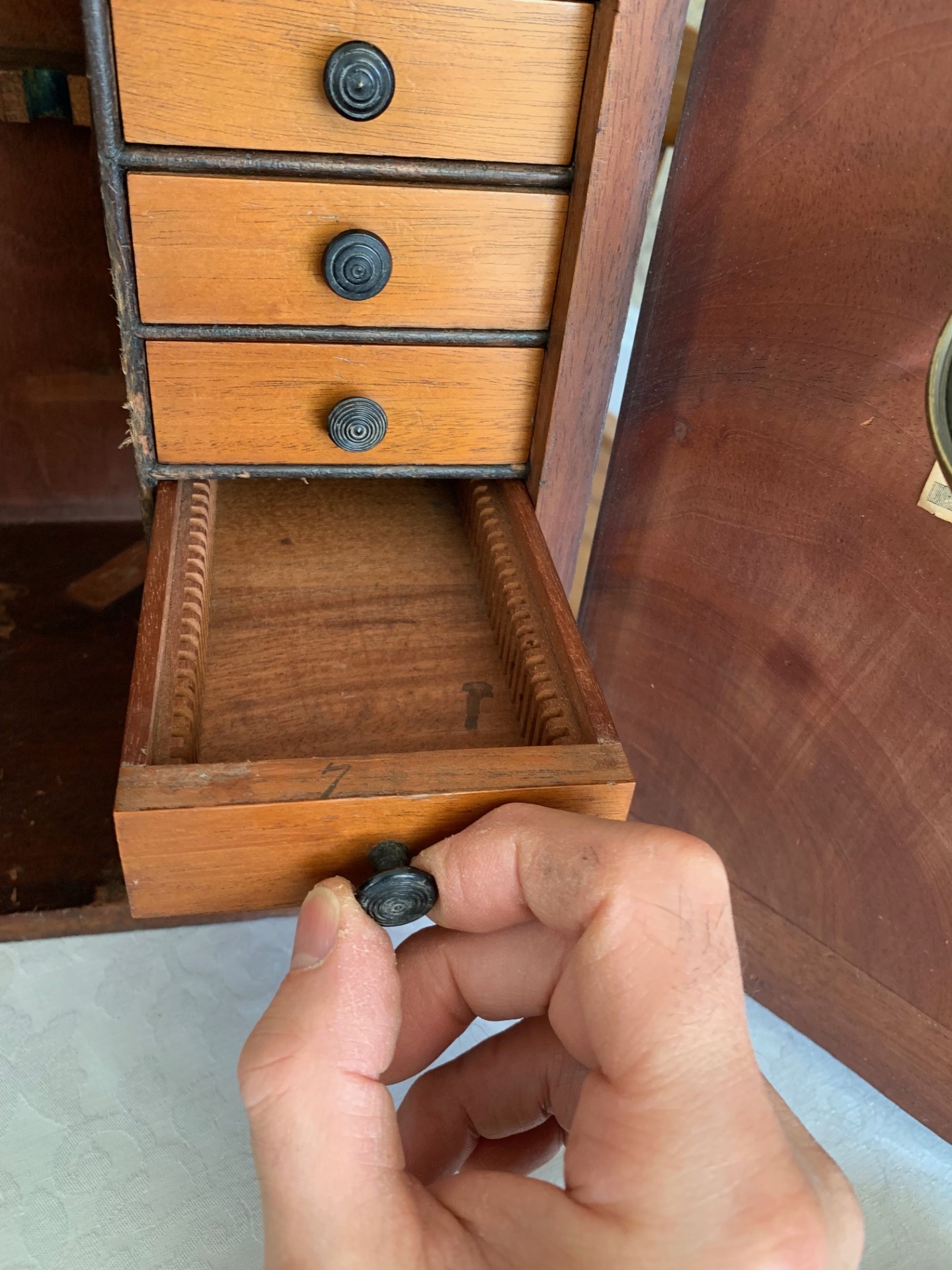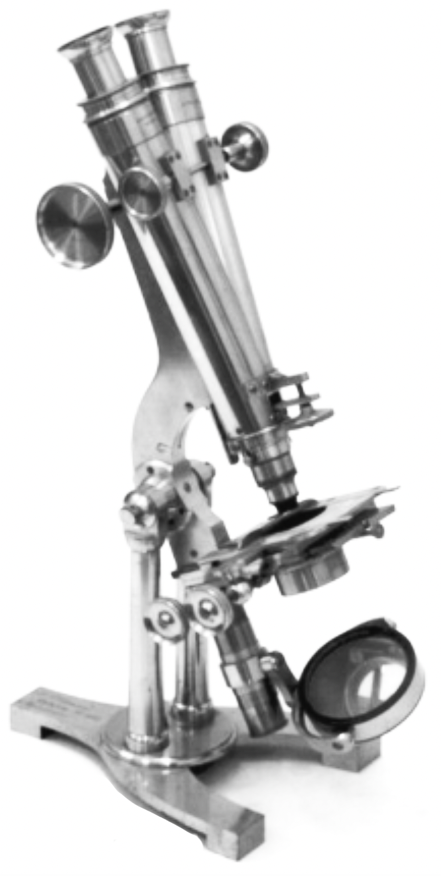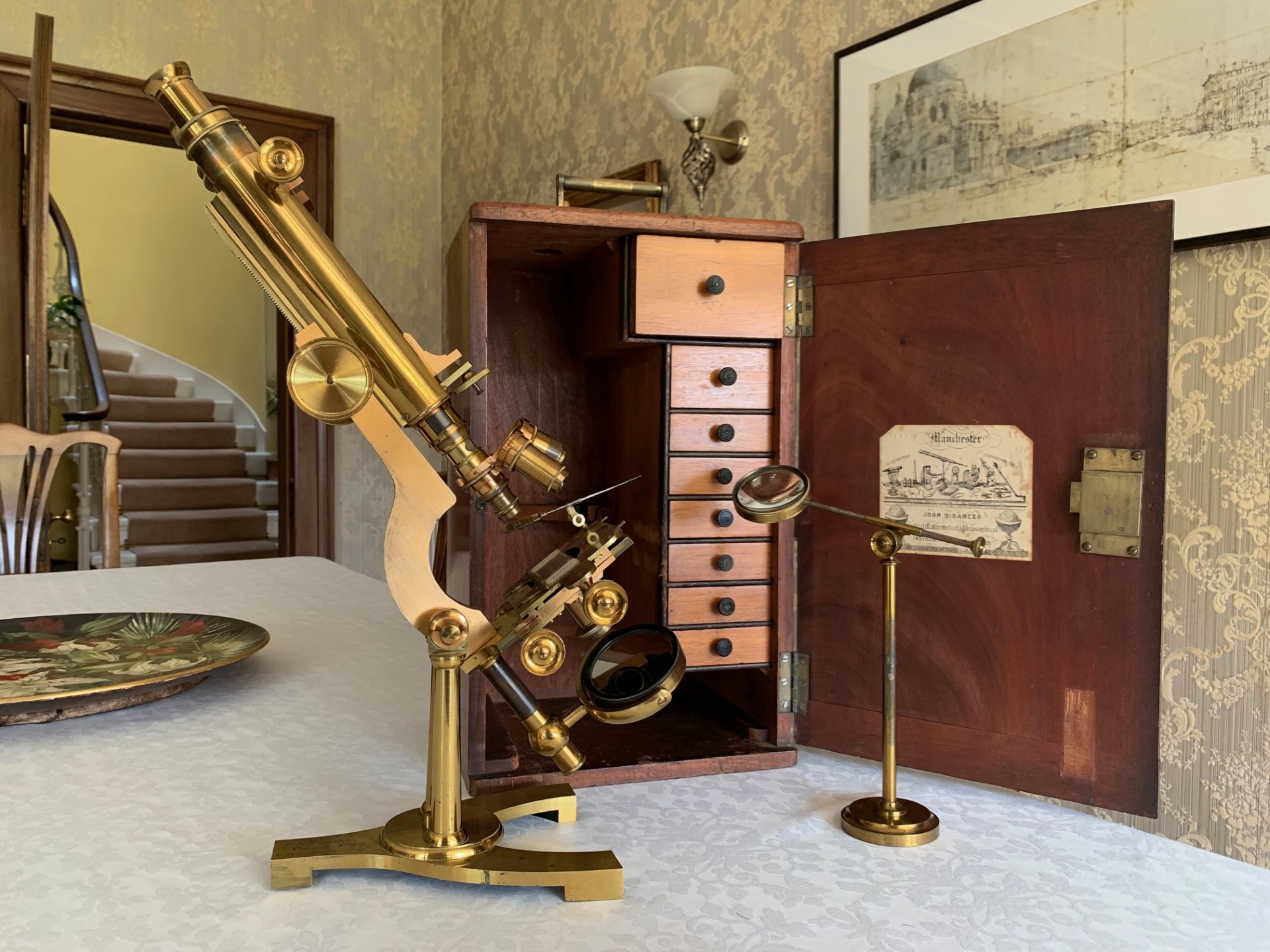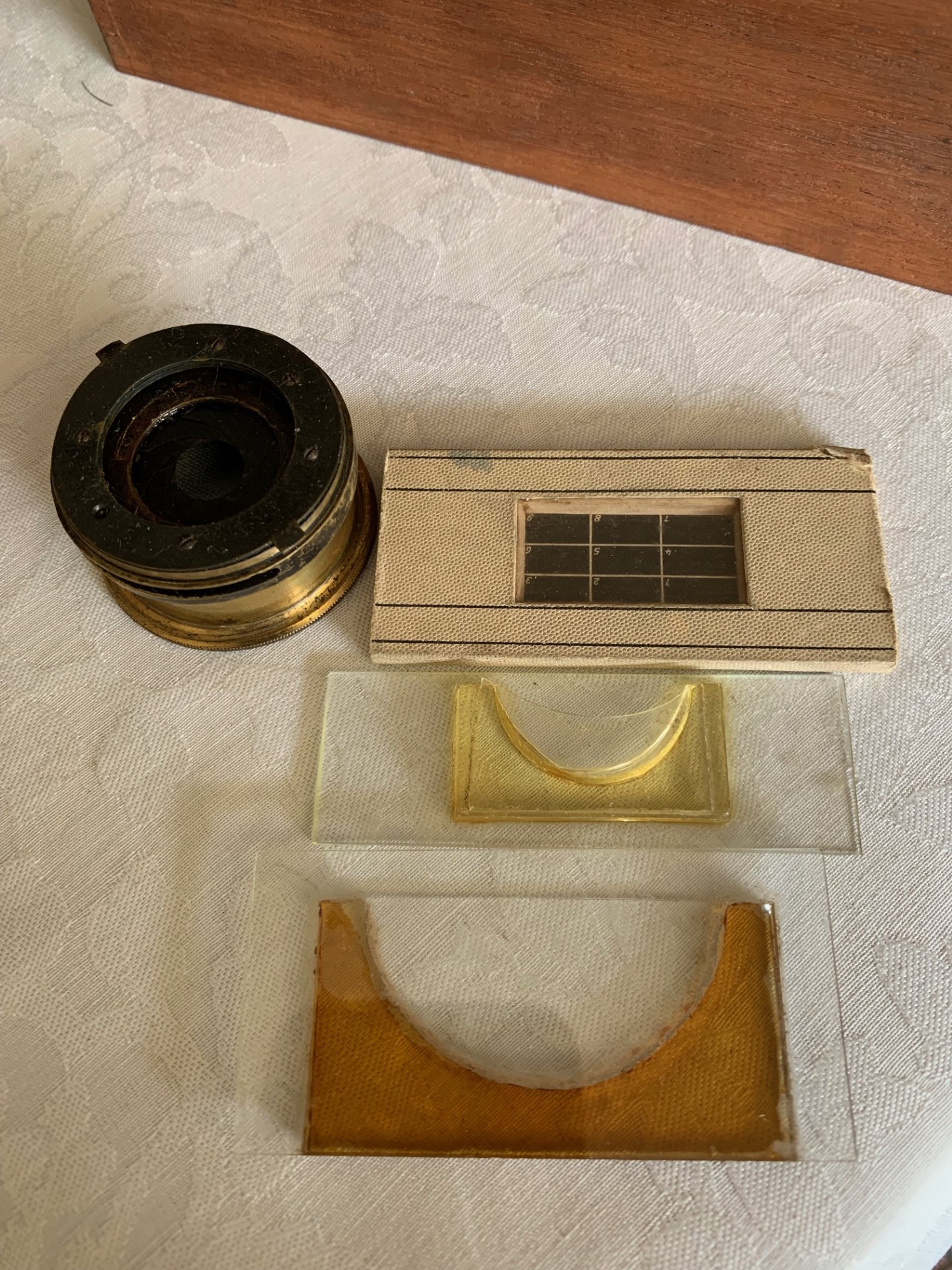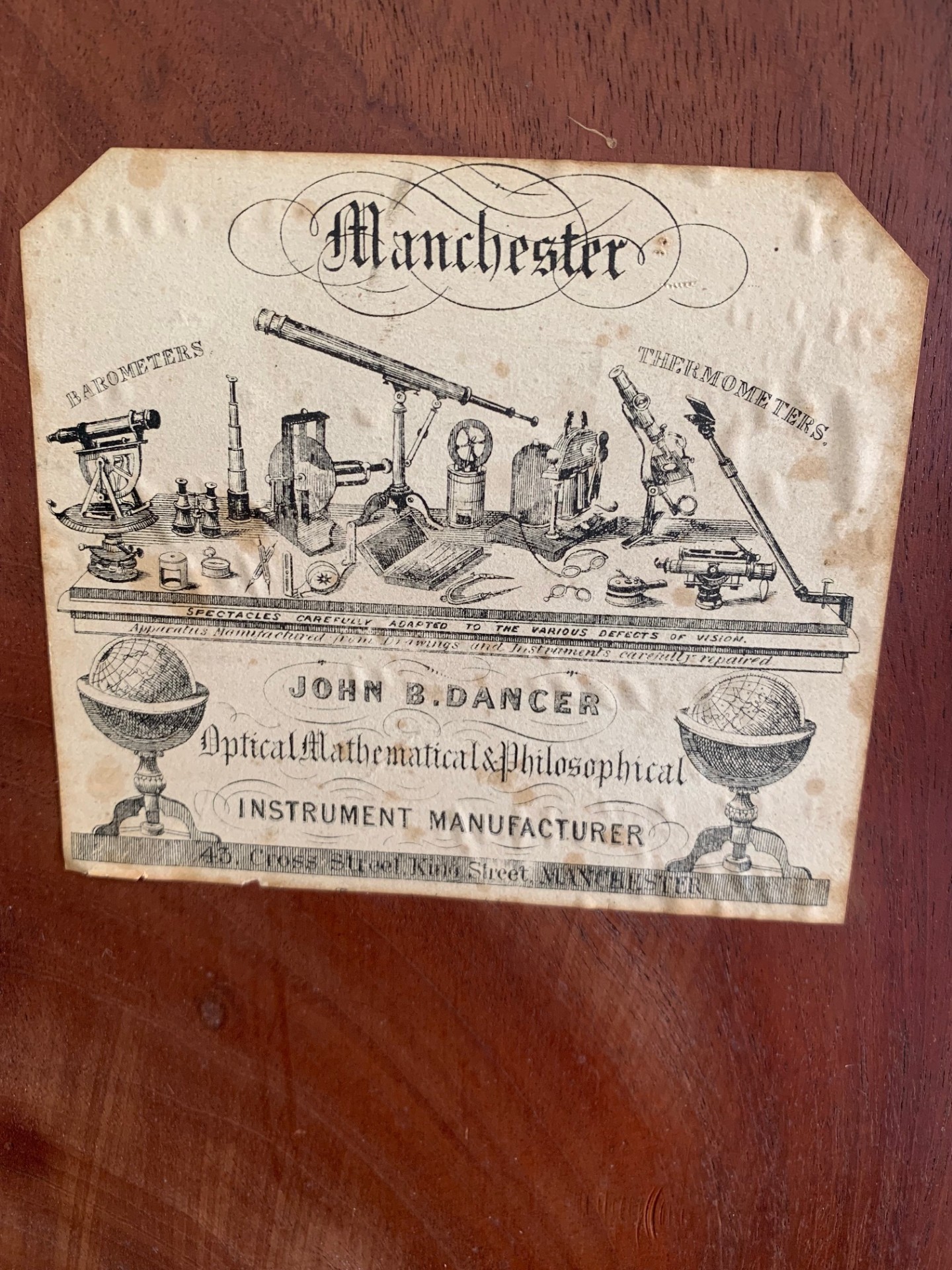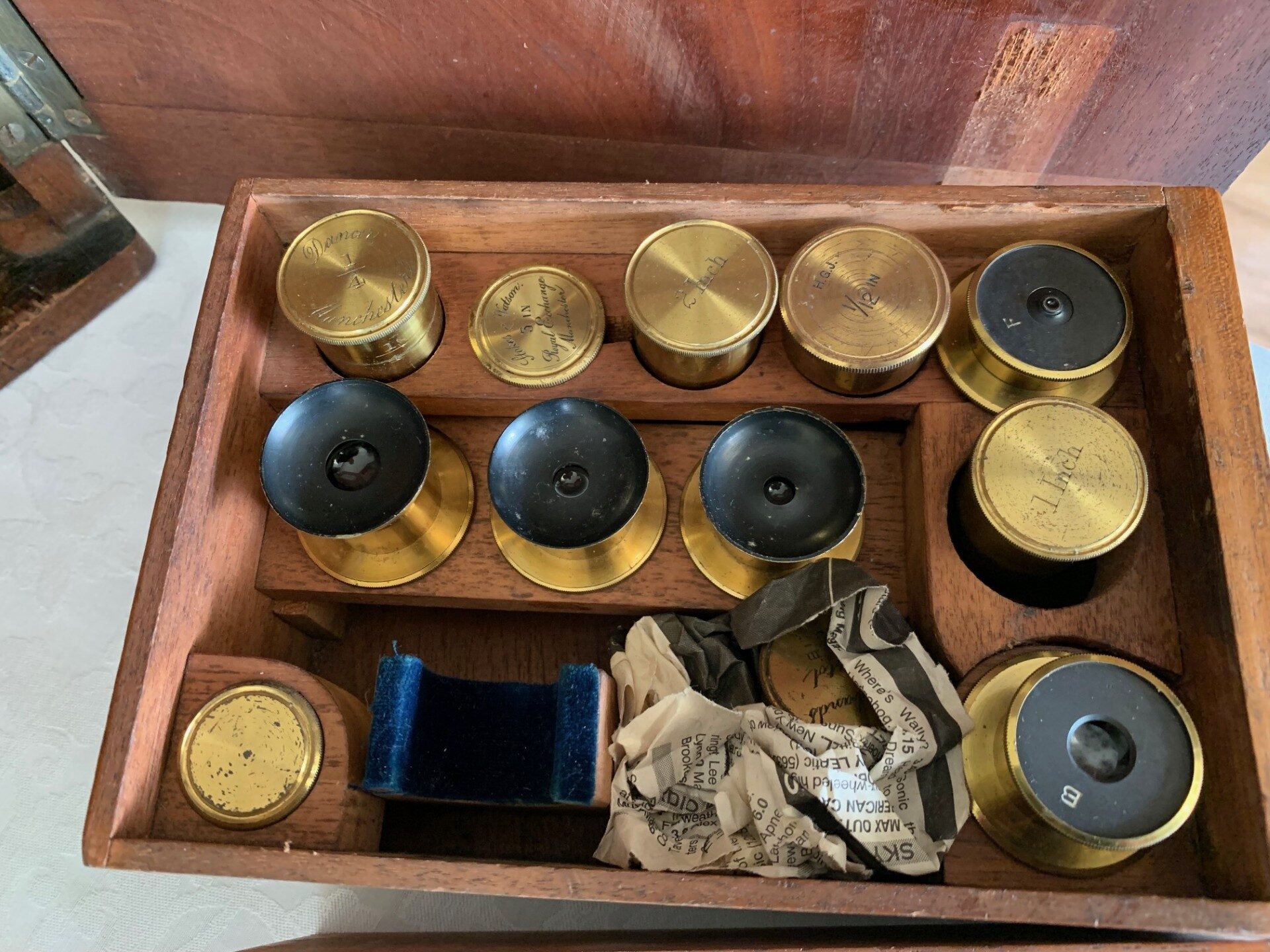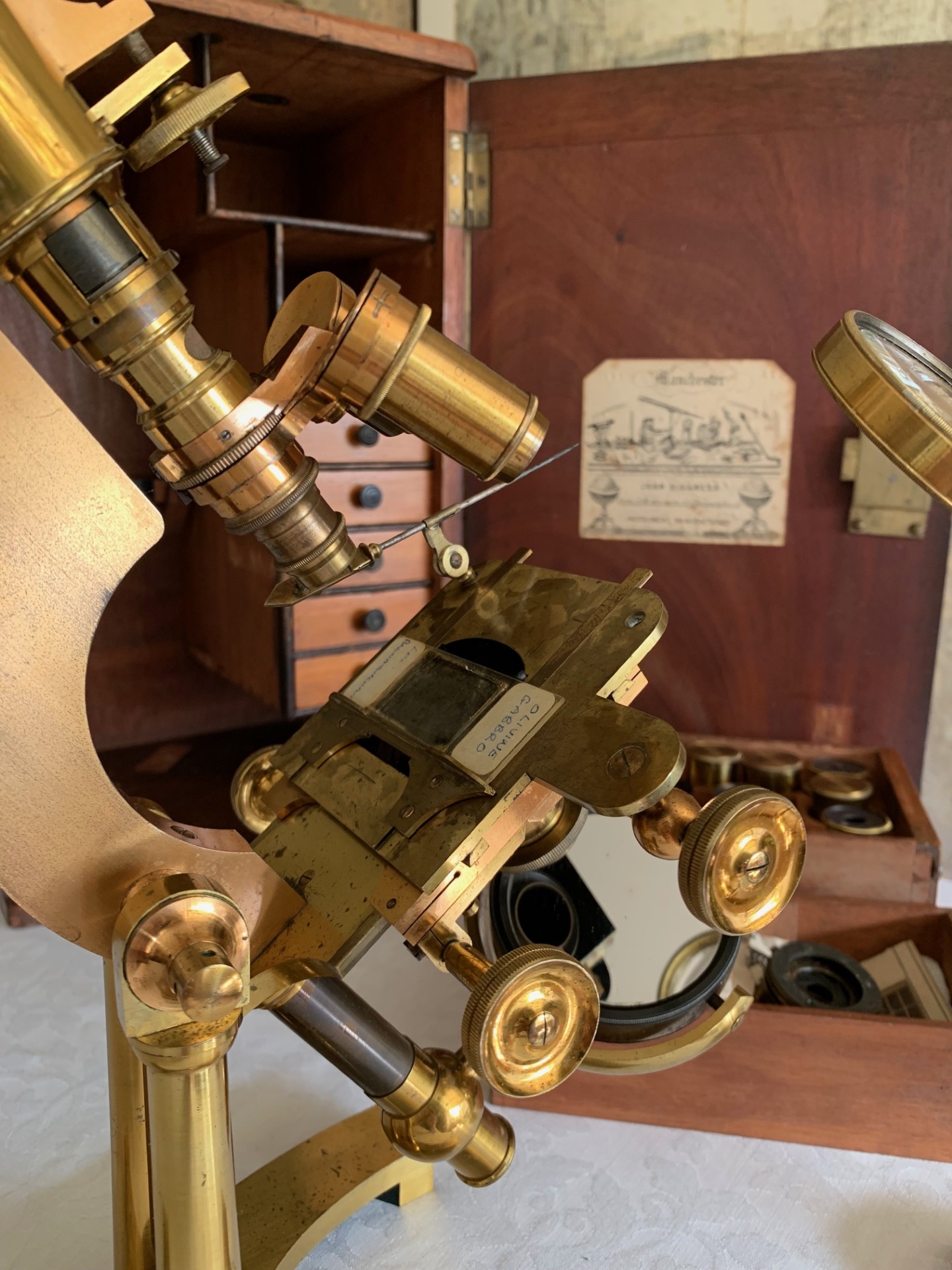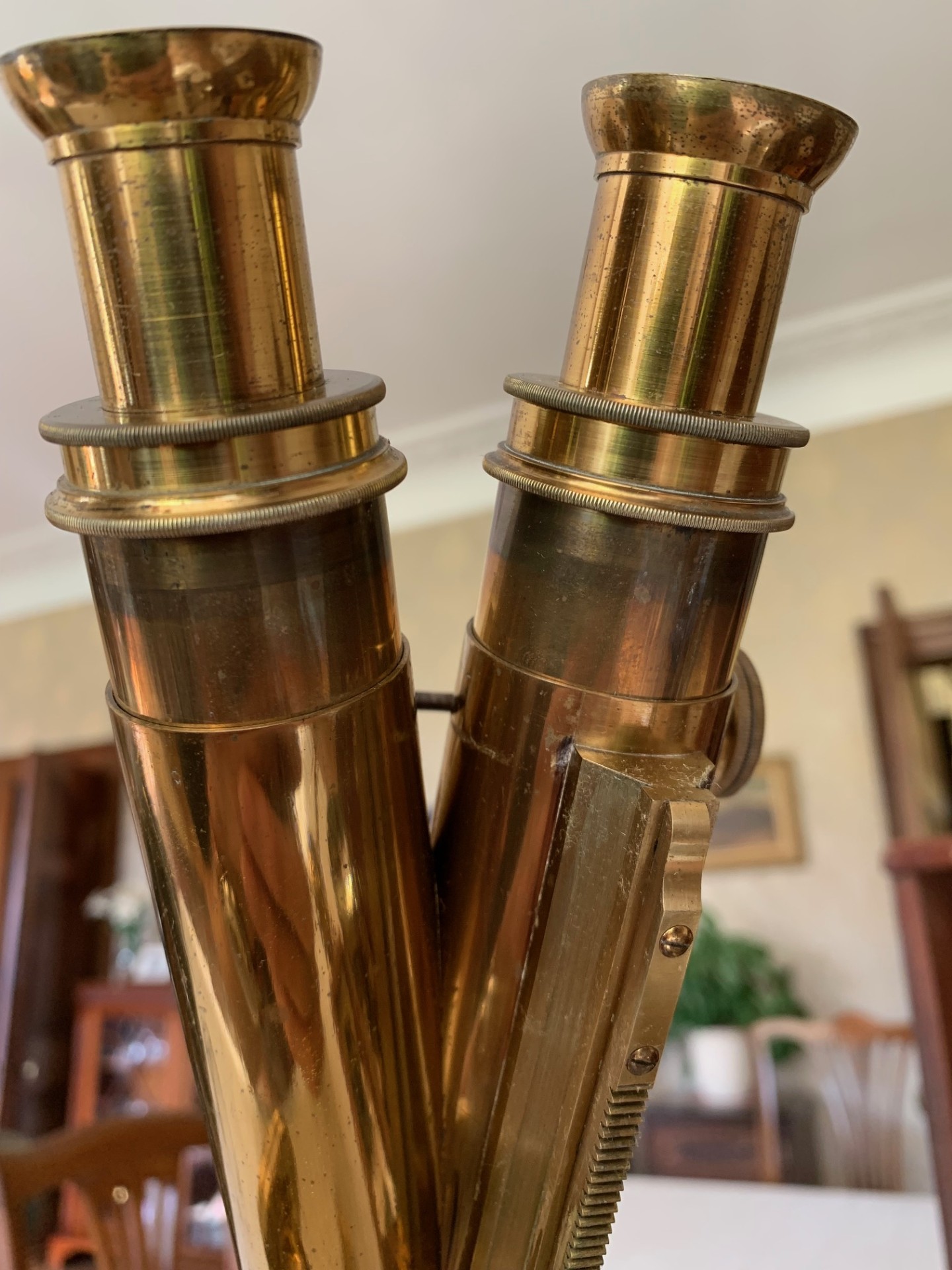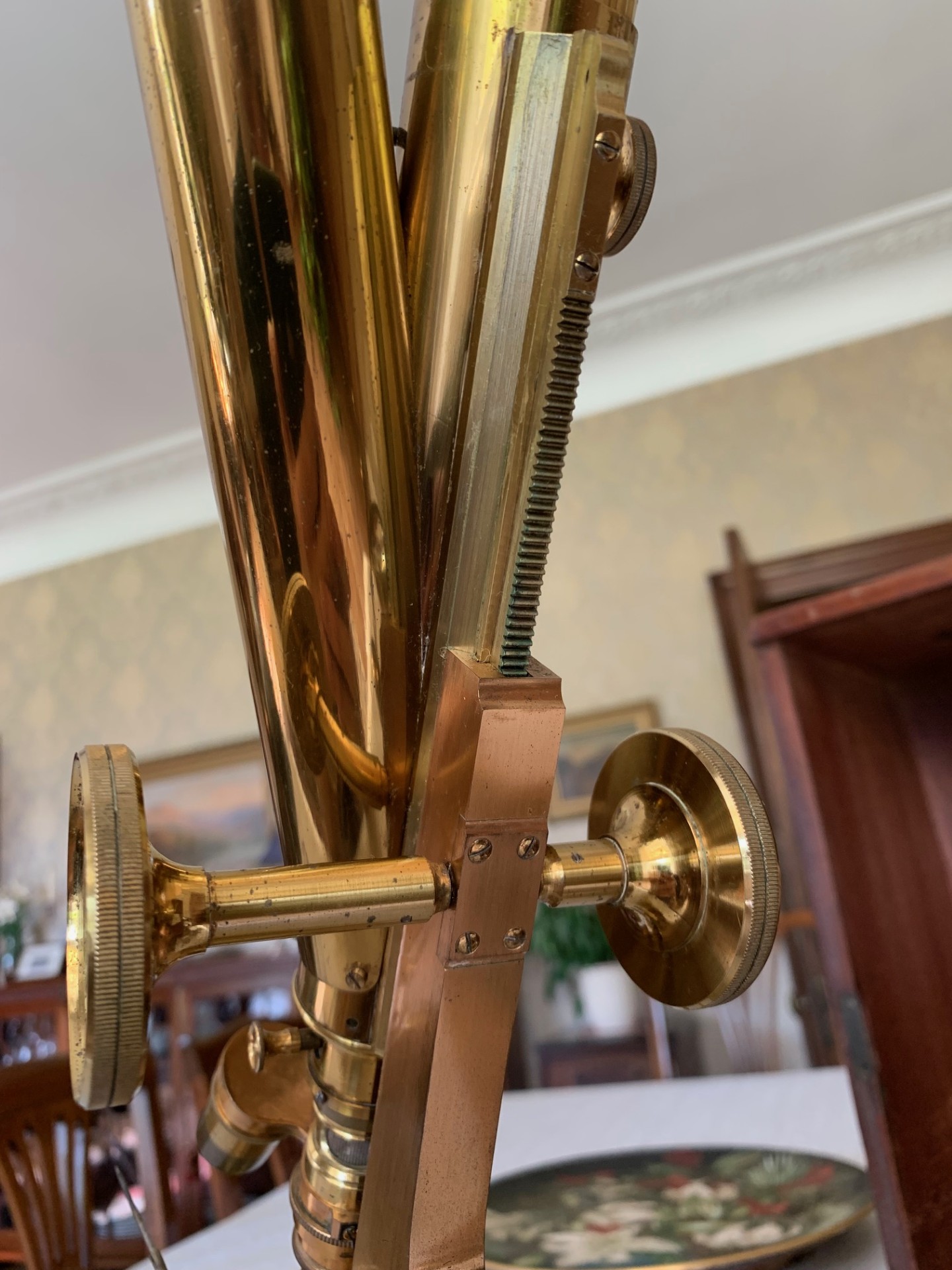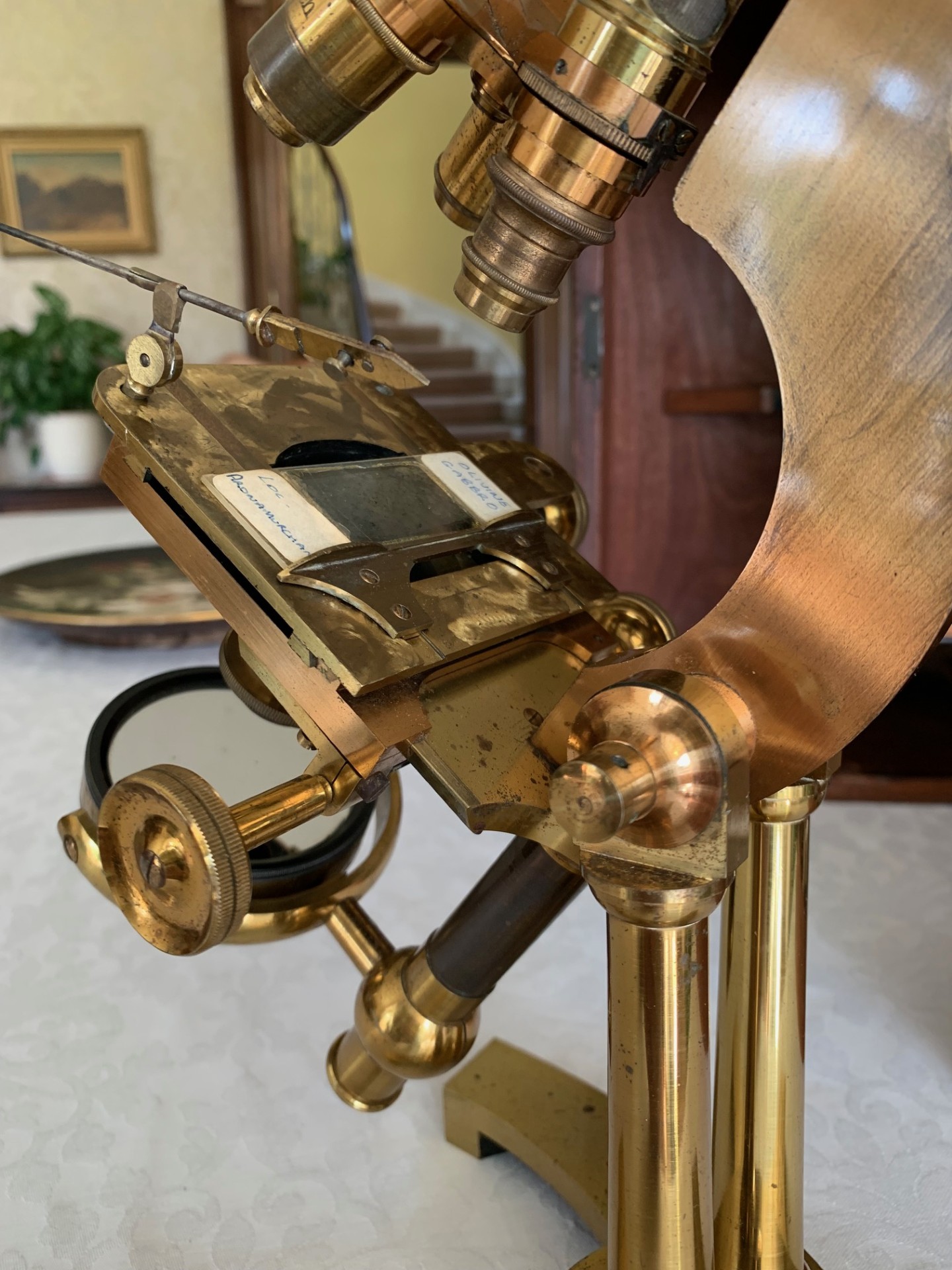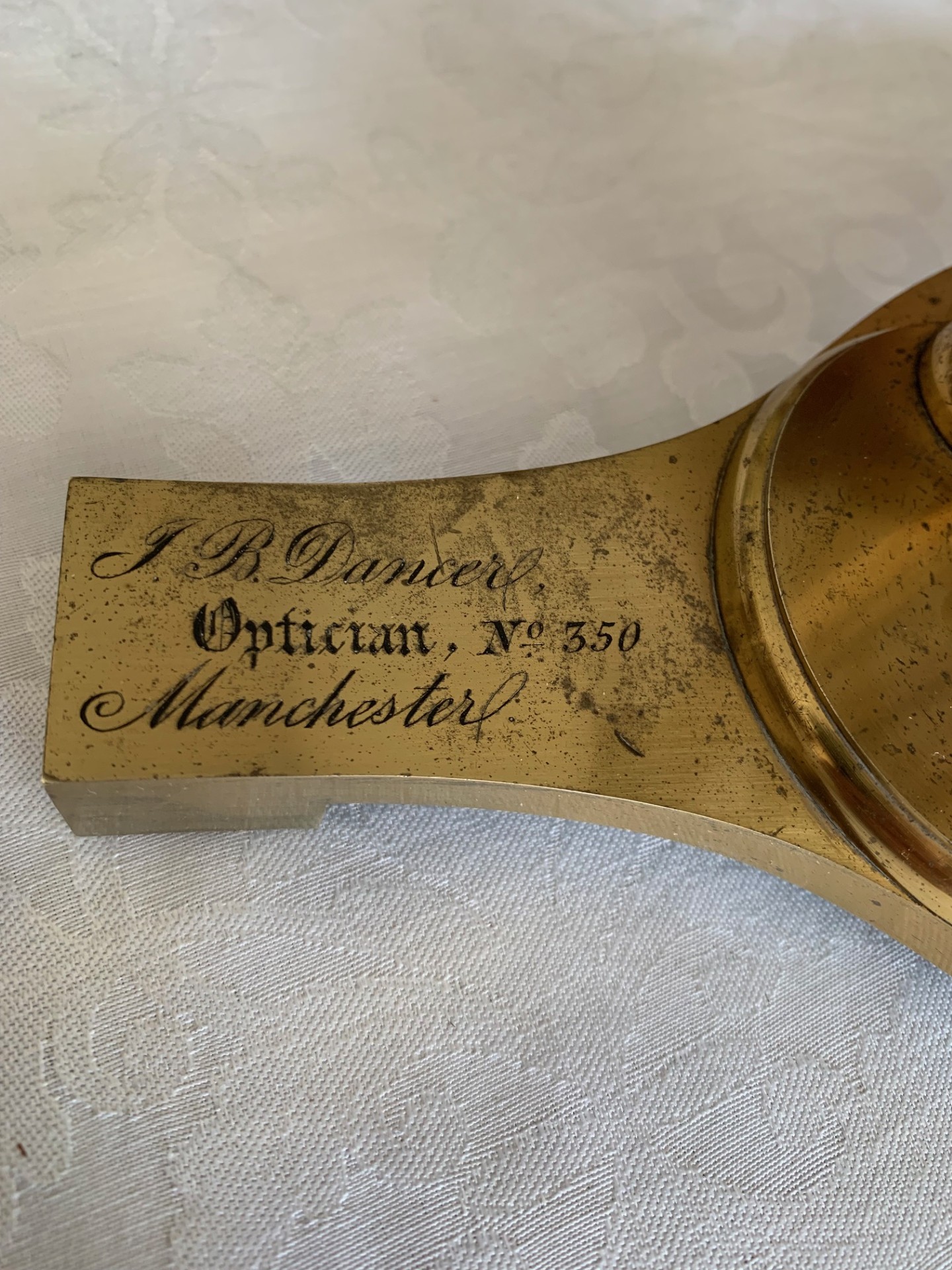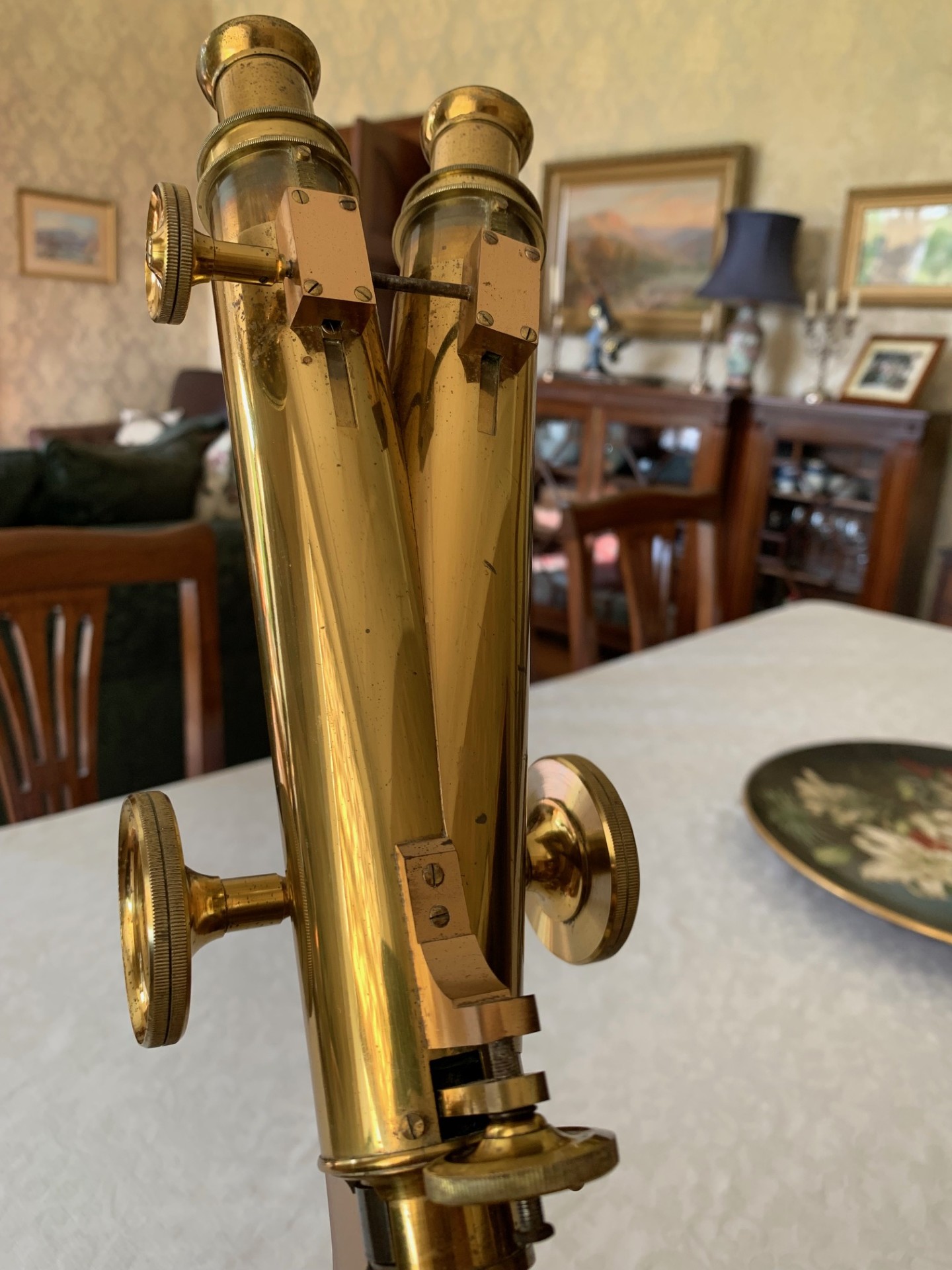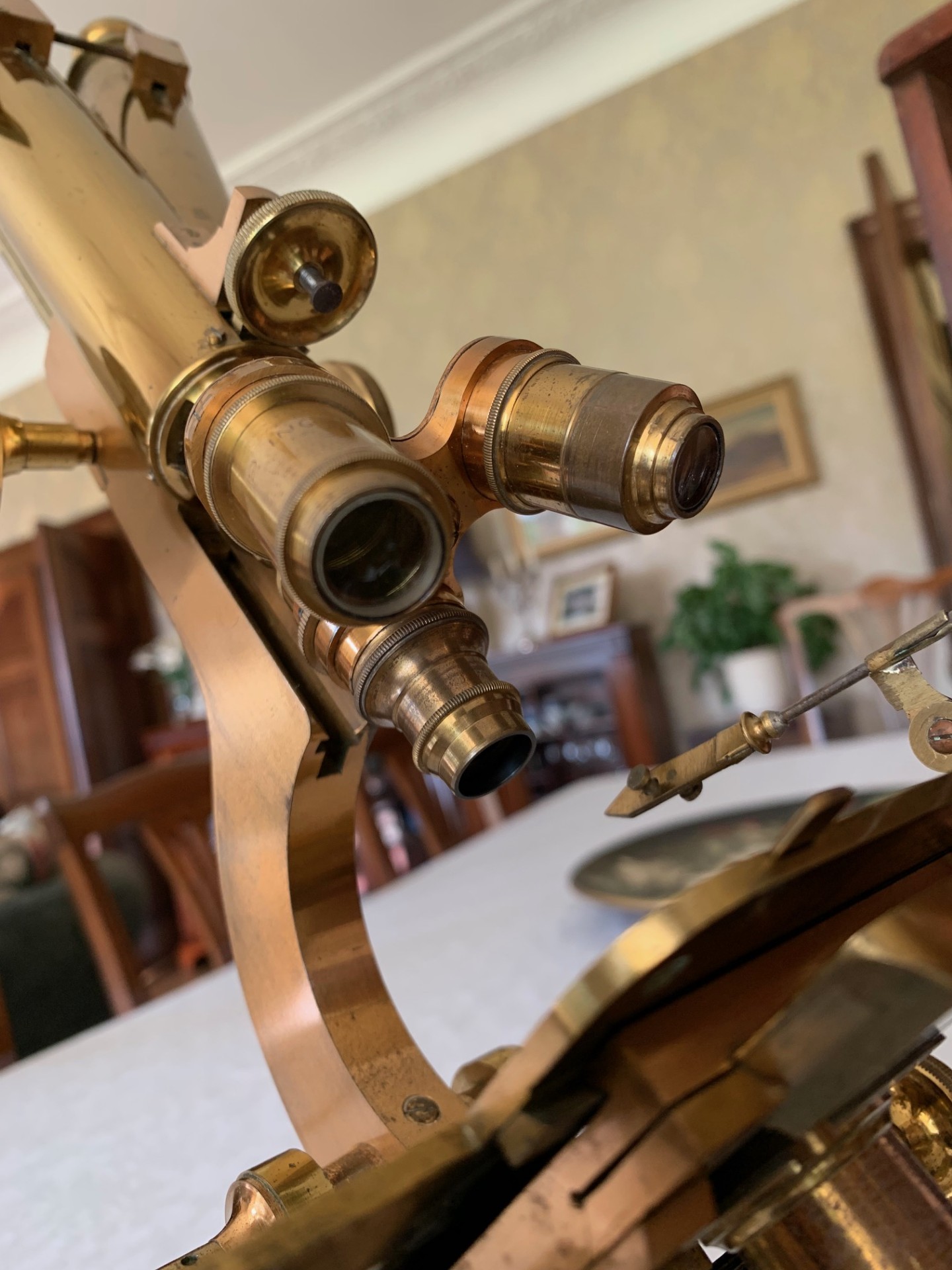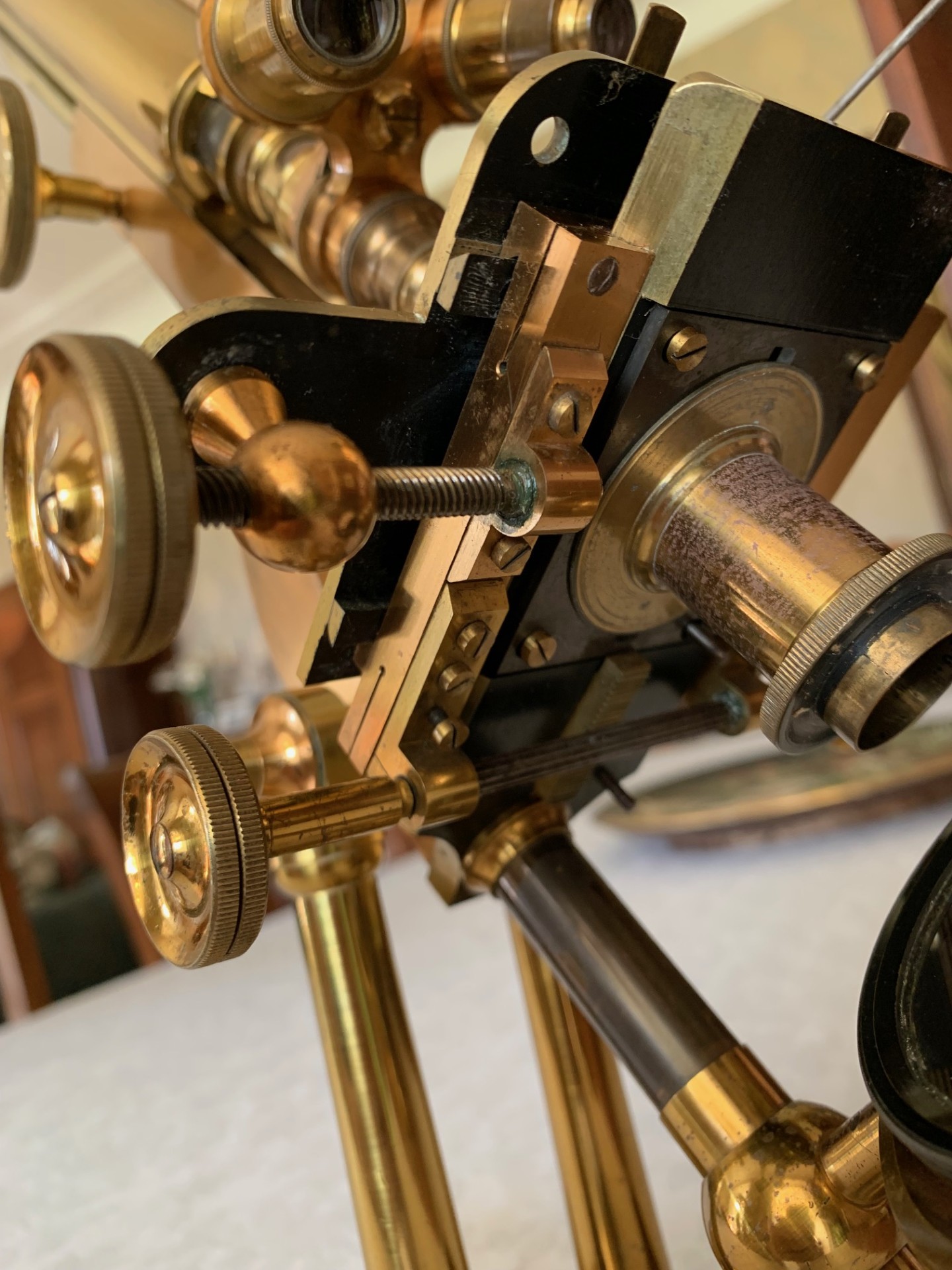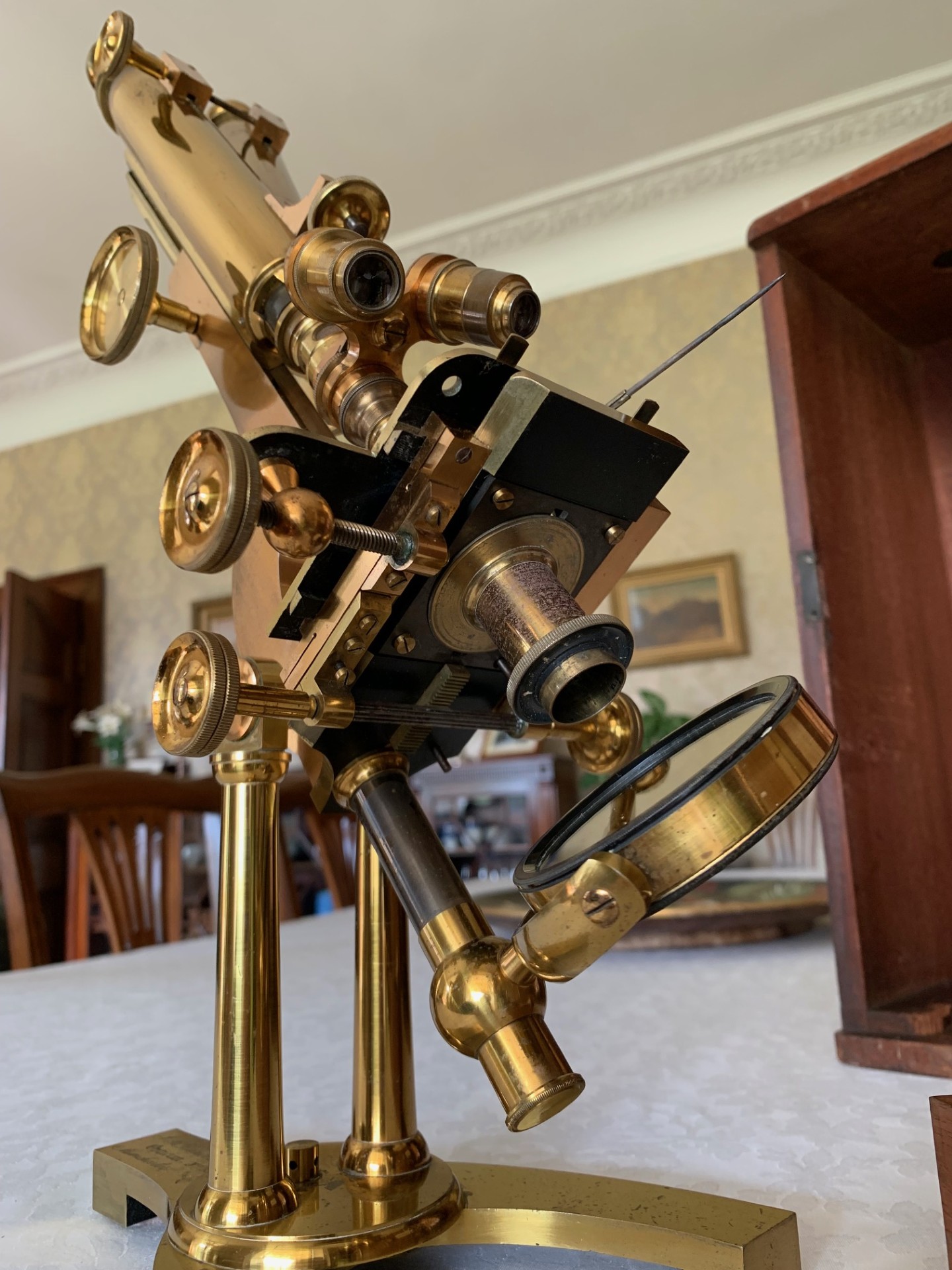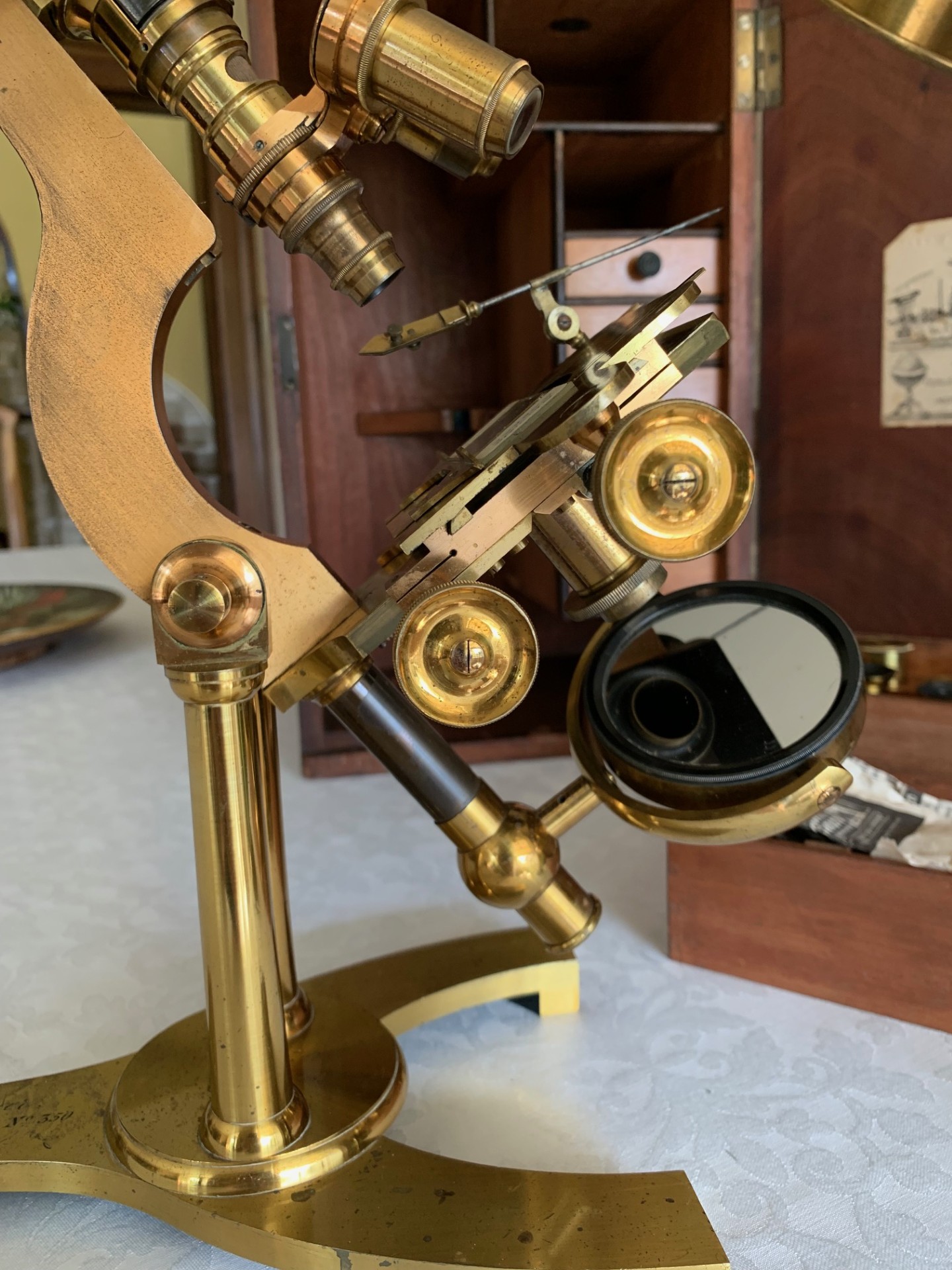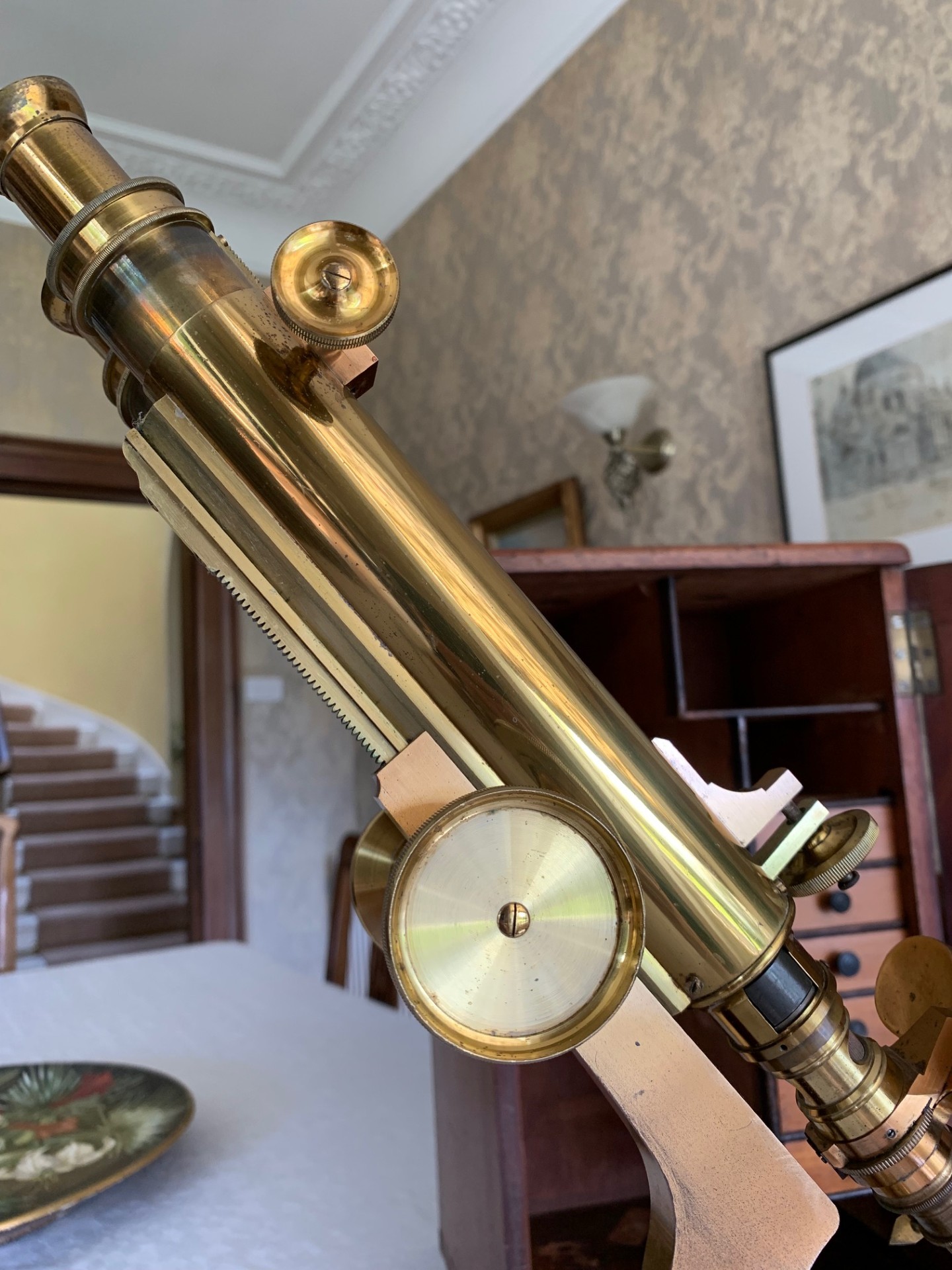SOLD – Antique No. 1 Binocular Microscope by John Benjamin Dancer, Manchester – c1865, Cased
Sold
Antique and generally extremely good condition binocular instrument manufactured by scientific instrument makers J. B. Dancer and dating to around 1865 with production serial number 350.
Circa
1865
Maker
John Benjamin Dancer, Manchester, England
Country of manufacture
UK and Ireland
Description
Background to J. B. Dancer (source – Antique Microscopes’ website):
John Benjamin Dancer was a well-known Manchester optician and instrument maker, born in London in 1812, the son of Josiah Dancer, also an optician and manufacturer of optical, philosophical and nautical instruments. Josiah and his family moved from London to Liverpool in 1817. JB Dancer took over his father’s business in 1835 and continued in business in Liverpool until 1841, when he entered into partnership with A. Abraham, a scientific instrument maker of Lord Street, Liverpool. He moved to Manchester to establish a branch of the business as Abraham & Dancer at 13 Cross Street. The partnership ceased in 1845. Dancer continued in business under his own name until 1878, when part of the business was transferred to his daughters Elizabeth Eleanor and Anna Maria (he had to give up his business activities because of ill health and poor vision). The business continued trading under the name of EE Dancer & Co. until 1900, when the entire stock and the process of producing quality microphotographs were sold to the London microscope dealer Richard Suter. Dancer became well known for the quality of his microscopes and received several honours, including a prize medal at the International Exhibition in London. He was appointed Optician in Manchester to the Prince of Wales. Dancer is perhaps best known for his photographic work, in particular on microphotography and the stereoscopic camera. He took the earliest known photograph of Manchester, showing a cutler’s shop at Market Street in 1842.
Turning to the technical details, the instrument stands on a heavy brass Y-shaped foot with twin uprights leading to the main pivot joint, which can be adjusted for tension if required. There’s a lister-type upper limb giving a good range of coarse focus travel, which should allow low power objectives of up to 4 inches to be used. The instrument tilts for inclined viewing and holds in position throughout the usable range of inclination. Coarse focus is via the older-style straight-cut rack and pinion, with smooth action and good rack with no missing teeth and the main binocular tubes holding in position as they should on adjustment. Fine focus is controlled via a separate brass thumb-wheel at the front of the optical tube acting one the nose-piece only and working as it should.
With its optics, this instrument is in binocular configuration with a Wenham-style prism in a carrier just above nosepiece, which is on an in/out slider and when set to “in” splits the light beam thereby illuminating both optical tubes. There’s mechanically extendable eyepiece draw-tubes operated by a rack and pinion system which works well. Extending the draw-tubes will increase magnification – you also have to re-focus. The optical prism operated via a slider allows use in both binocular and monocular configuration, with just the right-hand tube/eyepiece used for monocular observations (higher magnification). This is the reason why there’s so many single Dancer eyepieces supplied with the instrument – all for higher-power monocular observations – as detailed below.
There’s one pair of top-hat eyepieces by Dancer for binocular use:
– Set A – 5x magnification
There are also five single Dancer eyepieces for higher magnification monocular use:
– B – 6x magnification
– C – 8x magnification
– D – 10x magnification
– E – 15x magnification
– F – 20x magnification
There’s also a good set of mainly Dancer objective lenses in brass, as under – note the instrument is RMS in terms of objective thread diameter, so plenty of other objectives should also fit:
– 3 inches – 2.5x magnification
– 2 inches – 3x magnification
– 1.5 inches – 4x magnification by Husbands, Bristol
– 1 inch – 6x magnification
– 1/4 inch – approx 25x magnification
– 1/4 inch – approx 25x magnification with adjustment for coverslip thickness
( all objectives have period brass canisters)
The magnification range available is therefore around 15x to 500x with the current set of optics.
The fully mechanical rectangular brass stage is attached to the limb tail-piece just below the pivot point and is a well engineered feature that’s a delight to use, with nice smooth action to its moving parts. It’s got thumb-wheel x/y adjusters for both axes with smooth operation. The top-plate also has an integral sliding specimen holder/ledge for holding slides steady during inclined viewing and when the axes are being moved around which works well. The x/y controls have a nice solid stable feel about them, offering good accurate control of specimen positioning, which is a real advantage for detailed and high magnification work. The top-plate also has recesses for inter alia sage forceps and the like.
Turning to the sub-stage, we have a brass mount to which will fit accessories such as the supplied plug-in variable iris and a sub-stage polariser with rotation that’s shown fitted in the listing photos.
Lighting is via a plano-concave mirror in a brass carrier on a height/rotation adjustable brass support arm and gimbal, with period silvering that’s in excellent condition to both sides with some very minor losses at the margins, but still perfectly functional.
Accessories:
– bull’s-eye table-top condenser
– variable plug-in sub-stage iris
– rotatable polariser and RMS analyser – achieve extinction when crossed – appear to have integral polaroid films – working well
– stage forceps
– troughs for liquid specimens
– containment slide for liquid specimens
– some blank slides and coverslips
There’s also the correct substantial period hardwood case for the instrument and its accessories, with good exterior finish, very well fitted interior that can accommodate all the accessories in two good sized drawers and there’s six smaller drawers for adding your slide collection. There’s a good solid brass carry-handle and the lock is present and working with its key, which is always nice to have. Overall, a quality case befitting the quality instrument that resides within.
The instrument and its controls have been very gently dusted, lightly lubricated and operate smoothly with age-appropriate signs of wear as one would expect for an instrument of this quality and age. With its bright lacquered finishes and the signature double optical tubes, it’ll make a great display piece in the right setting and is also quite a usable instrument. It presents really well and I’m certain it will look the part in a library or home office, especially when set up with an appropriate antique slide, such as the thin-section mineral slide (Olivine Gabbro from Ardnamurchan in the Scottish Highlands) I was examining using polarised light.
Owing to the weight and delicacy of this antique microscope, it will be partially dismantled, carefully wrapped for shipping and dispatched by insured courier upon receipt of cleared funds.
Thanks for looking.
Ask the Dealer
Dealer information
 Arcboutant Scientific
Arcboutant Scientific
Howard Nutton based in Glasgow Scotland with a background in Natural Science along with previous career in risk management. I obtained my first antique microscope in 1988 - it was a Watson Edinburgh model H serial number 23604 - dating it to 1918. Since that time I've owned and restored hundreds of similar instruments. As Arcboutant Scientific now also making available personally curated fine examples, principally of antique microscopes and associated scientific equipment by quality English and Continental makers, to collectors world-wide.




